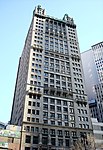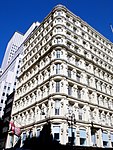Theatre Alley
Financial District, ManhattanNew York City geography stubsStreets in Manhattan

Theatre Alley is a block-long cobblestone alley in the Financial District of Manhattan, New York City, between Ann and Beekman Streets. It is one of Manhattan's few alleys that is not privately owned, and prior to the expansion of 5 Beekman Street adjacent to the alley c. 2010, it was "dank and claustrophobic".The alley was named for adjacent Park Theatre, which burned down in 1848. According to Forgotten NY, it was New York's first one-way street, created to alleviate traffic jams caused by horse-drawn carriages arriving at the theater.
Excerpt from the Wikipedia article Theatre Alley (License: CC BY-SA 3.0, Authors, Images).Theatre Alley
Nassau Street, New York Manhattan
Geographical coordinates (GPS) Address Nearby Places Show on map
Geographical coordinates (GPS)
| Latitude | Longitude |
|---|---|
| N 40.7111 ° | E -74.0073 ° |
Address
Nassau Street 115
10038 New York, Manhattan
New York, United States
Open on Google Maps










